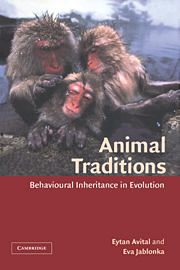Book contents
- Frontmatter
- Contents
- Preface
- Acknowledgements
- 1 New rules for old games
- 2 What is pulling the strings of behaviour?
- 3 Learning and the behavioural inheritance system
- 4 Parental care – the highroad to family traditions
- 5 Achieving harmony between mates — the learning route
- 6 Parents and offspring – too much conflict?
- 7 Alloparental care – an additional channel of information transfer
- 8 The origins and persistence of group legacies
- 9 Darwin meets Lamarck – the co-evolution of genes and learning
- 10 The free phenotype
- References
- Index of species
- Index of subjects
8 - The origins and persistence of group legacies
Published online by Cambridge University Press: 28 October 2009
- Frontmatter
- Contents
- Preface
- Acknowledgements
- 1 New rules for old games
- 2 What is pulling the strings of behaviour?
- 3 Learning and the behavioural inheritance system
- 4 Parental care – the highroad to family traditions
- 5 Achieving harmony between mates — the learning route
- 6 Parents and offspring – too much conflict?
- 7 Alloparental care – an additional channel of information transfer
- 8 The origins and persistence of group legacies
- 9 Darwin meets Lamarck – the co-evolution of genes and learning
- 10 The free phenotype
- References
- Index of species
- Index of subjects
Summary
Up to this point, we have concentrated on social learning and its consequences in nuclear and extended families, where information is transferred between mates, between biological or adoptive parents and their offspring, between helpers and those they help, and among sibs. We now want to widen our discussion to see what goes on in those species of birds and mammals that are highly social, living in more or less permanent groups composed of both related and unrelated individuals. Our aim in this chapter is not to carry out an extensive review of the social group-life of birds and mammals. Rather, we want to look at some aspects of behaviour and psychology that throw light on the formation and maintenance of group traditions, and see how these group traditions themselves influence, directly or indirectly, the evolutionary development of social behaviour. We shall show how the various psychological mechanisms that serve to organise and co-ordinate the activities of a group depend on a constant flow of information among its members. This flow of information is mediated through social learning and maintained by frequent social interactions.
Before starting this discussion, we want to take a close look at the real-life intricacies of a group-living social mammal. So, imagine a cloudless day in January, in the Kalahari desert of south-west Africa, where we are watching the activities of meerkats, the social mongooses that live in small groups on the dry, open plain along the Nossob river.
- Type
- Chapter
- Information
- Animal TraditionsBehavioural Inheritance in Evolution, pp. 243 - 303Publisher: Cambridge University PressPrint publication year: 2000



